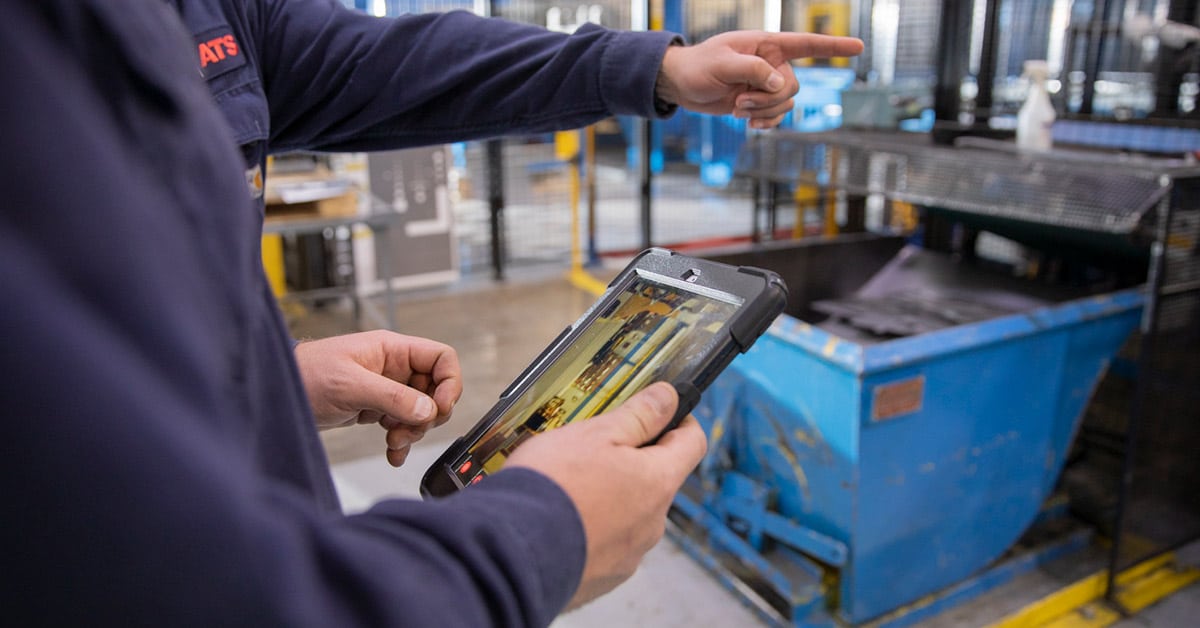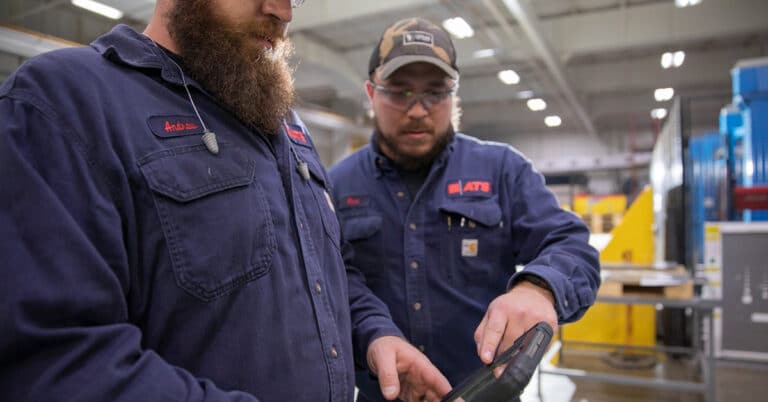Predictive maintenance is a strategy where machine health monitoring is used to look for signs of impending failure. Maintenance work orders are then issued just before failure is expected. This avoids doing preventive maintenance work that is either unnecessary or done too often, so increasing machine availability.
Mobile maintenance management tools can play a big role in helping manufacturers implement predictive maintenance. This blog discusses the benefits of moving to mobile enterprise asset management.
Key benefits of mobile technology in predictive maintenance
“Mobile technology” refers to primarily smartphones and tablets that are taken out on the plant floor or to remote locations. It can also cover augmented reality (AR) headsets that overlay computer graphics onto the scene being viewed. In a predictive maintenance strategy, these devices are used for tasks such as:
- Interrogating and downloading data from equipment
- Taking pictures for discussions with colleagues or to add to the machine history
- Downloading work orders and submitting updates when appropriate
- Accessing repair manuals
- Checking spare parts inventory
- Accessing remote support services for troubleshooting assistance
- Viewing repair histories for the equipment being attended to
The reasons for using mobile technology for these kinds of activities can be grouped under:
- Real-time data access
- Improved communication and collaboration
- Streamlined workflows
- Enhanced data capture and analysis
Mobile devices can support machine data collection, accessing and downloading files from sensors and controllers built into the equipment under repair. This could include log files of incidents or problems, plus statistics and trends.
Work orders can be viewed while at the machine and data can be pulled down from the predictive maintenance program or Computerized Maintenance Management System (CMMS) to help understand the work needed. Repair histories are available to see if the problem has occurred previously and, if so, what was done. When the work is complete, the work order can be updated immediately ensuring more accurate reporting.
Essential mobile features for predictive maintenance
Besides size and operating system, (large enough to view pictures and diagrams clearly, compatible with mobile maintenance software), there are a number of other essential features.
Industrially rugged
Consumer devices will not last long in a maintenance environment. Cracked screens are inevitable, and damaged controls and water immersion highly likely. To minimize costs, and overcome a reticence to use personal devices, the business should invest in industrial-grade mobile technology proven to work and survive in a busy factory. If technicians are likely to be wearing gloves when using the devices, look for screens that are engineered accordingly or devices with physical keyboards.
Multiple communication protocols
In some plants WiFi will be the preferred means of communication, but this won’t work everywhere. Water treatment facilities or dust collection plants for example may be out of WiFi range. Most new devices take advantage of the high speed 5G technology (typical speeds of 150-200 Mb/sec) but in more remote areas where signal strength is poor 4G may be needed instead.
Sensor integration
With some equipment, it may be useful to connect to manufacturing sensors via Bluetooth: make sure this capability is available on the chosen devices. These sensors measure characteristics like vibration, temperature, current, pressure and humidity, and the data is being used increasingly as the basis of machine health monitoring systems.
Other sensor interfaces that may be needed, so look for them or the ability to add adapters, are USB and RS232/485.
Cameras
Higher resolution is always preferred, although note that this requires more storage and can slow data transmission. Some devices are available with infrared/thermal imaging cameras or adapters, which can be useful for diagnostics.
Offline functionality
Some remote factory areas may have no connectivity at all. In such circumstances, the mobile device must continue to operate, saving data for uploading later.
Integration with mobile CMMS software
Time savings are maximized when technicians can remotely access the benefits of a CMMS. If adding mobile technology to an existing system, check the systems will synchronize seamlessly for efficient data transfer. Alternatively, if implementing mobile as part of a new CMMS, look for packages including mobile CMMS capabilities.
User-friendly interfaces
Mobile maintenance software should be intuitive for technicians of all experience levels.
Implementing mobile technology for predictive maintenance
Mobile technology can play a big role in effective predictive maintenance, but there are some challenges to address and best practices to observe.
Challenges
- Cybersecurity: Should be top-of-mind when connecting any device to the company IT and OT networks. Work with the IT function and educate technicians on how to avoid threats and attacks.
- Moving to new working practices: For those comfortable working with paper work orders and manuals, the change can be difficult.
- Connectivity challenges: Sometimes can be a problem with IIoT technology.. Machines may need updating with new sensors or with adapters that can communicate with the mobile maintenance devices.
Best practices
- Partner with IT: Explore and address security and connectivity issues with the IT team at the start of the project.
- Training for those who will be using the mobile technology: Programs should address not only the software on the devices but the changes in workflow and work practices it enables.
- Implementation: A pilot study and a phased rollout usually yield most success. This provides opportunities to identify and address bugs and deficiencies without undermining confidence in the technology. Look for initial areas where mobile technology can have a big impact, especially in terms of enabling predictive maintenance.
- Legacy equipment: If there is older equipment that cannot be equipped with machine health sensors, it may be necessary to leave this out of the new system. To avoid future problems, incorporate connectivity requirements into future equipment specifications.
A partner for maintenance support
Even if you haven’t officially adopted mobile maintenance management, chances are your technicians already use their devices to contact remote support, take pictures and download important documentation. Taking a formal approach to mobile enterprise asset management and using rugged industrial devices with CMMS integration will provide bigger benefits. In particular, it will support a transition to predictive maintenance.
ATS helps manufacturers adopt best practices in maintenance management and offers a range of predictive maintenance services. Contact us to learn more about this and other ways in which we work to reduce machine downtime.






